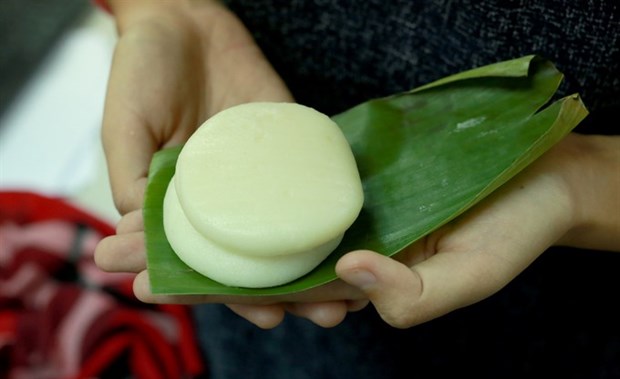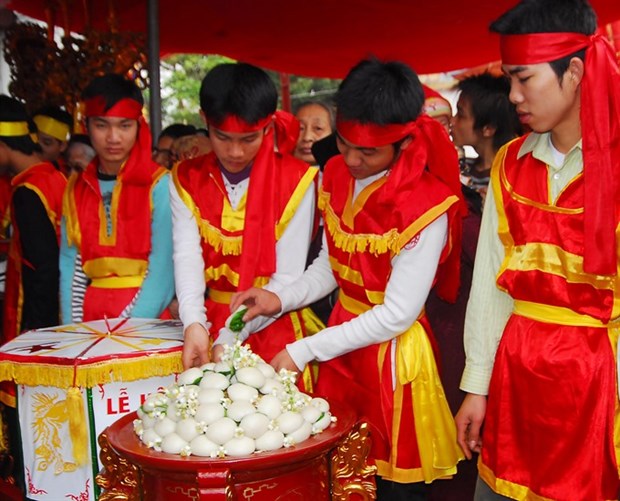Been to a Vietnamese wedding banquet? If so, you must have tried bánh giầy, a white, flat round cake made of glutinous rice with or without mung beans inside.

Simple: The white, “chubby” cakes, which are packed neatly in either green dong (Phrynium placentarium) leaves or banana leaves, are often served on special occasions, including the Lunar New Year. Photo Trương Vị
The
white, “chubby” cakes, which are packed neatly in either green dong leaves or banana leaves, are often
served on special occasions, including New Year.
The
best product is said to be from Quán Gánh Village, about 15 kilometres from
central Hà Nội. Villagers deliver their specialty all over the country, where
it is served up in restaurants, parties or used as a quick and convenient item
for breakfast.
Nowadays,
when one has a chance to pass by Quán Gánh on Highway 1A, they will notice
booths displaying layer upon layer of bánh
giầy.
Quán
Gánh was once the place where students from different regions rested before
heading to the royal capital to take the national exam, the most anticipated
and important one in the life of students in feudal time. This cakes formed
part of the diet of students before they took the exam.
How
the villagers acquired the skill of making these cakes is a moving story about
the warm hearts of the people here.

Ancestral tribute: A bánh giầy making competition held annually in Hoài Đức District of Hà Nội. Making bánh giầy is a tribute to the ancestors of Vietnamese people. Photo Doãn Tấn
It
is said in the old days, there was a beggar passing by Quán Gánh. He rested in
the village to seek accommodation. Despite the beggar’s dirty and tattered
appearance, villagers treated him very well. Being moved by the warm welcome,
the beggar taught the villagers to make bánh
giầy.
Over
the years, the villagers have not only preserved the tradition, but boosted the
reputation of Quán Gánh bánh giầy in
other parts of the country.
Bánh giầy is made from glutinous rice.
It
is tedious work and the villagers must wake up early. The work requires several
people. One is in charge of steaming the glutinous rice, the other mashes steamed
mung beans by hand with a mortar and shape it into small balls.
The
rice is soaked overnight then steamed in the morning and ground and shaped into
flat, round patties. These are finally stuffed with the mung bean ball and
wrapped in dong leaves.
Each
step must be done quickly so that the cakes are ready for sale in the morning.
In the old days, locals had to ground steamed rice by hand yet now it is done
by machine.
There
are three types of bánh giầy – a
sweet one with sugar, mung beans and dried coconut inside; a salted one with
salted mung beans, pork fat and pepper inside; and one without filling. The
last is often served with Vietnamese pork sausage.
The
aroma of glutinous rice blended with dong leaves lingers when after the first
bite.
An
old version of origin of bánh giầy
dates back several centuries. The story is so well known because it is
mentioned in textbooks for secondary schools.
Legend
has it that more than 2,000 years ago, the sixth Hùng King wanted to find a person to succeed him. He gathered the
princes and said he would give the throne to the one who could offer him a dish
that would delight him and expressed filial piety.
Many
princes sought a dish that could delight their king. Among them was, Lang Liêu, the 18th prince, whose mother
died when he was small and had to struggle without help.
One
day Lang Liêu dreamt of a saint
instructing him to make a square and a round cake made from rice, as rice is
the indispensable staple of Vietnamese people.
Lang Liêu followed his dream, offering the
king the two cakes (one square-shaped and one round-shaped), which symbolised
the sky and the earth and depicted the great gratitude of the child to his
parents.
While
others siblings offered the king luxury food, Lang Liêu won the heart of the king with his simple dishes. He was
chosen to be the next emperor.
Since
then, Vietnamese people have offered the two cakes at New Year and special
occasions. This are also two indispensable cakes presented on the altar on the
memorial day of the Hùng Kings.
Making
bánh giầy is a tribute to the
ancestors and parents of Vietnamese people. Bánh
chưng (square cake) and bánh giầy
symbolise the simplicity and deep appreciation of the descendents to heaven...
and their ancestors.
By VNS